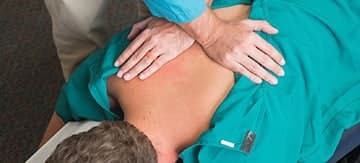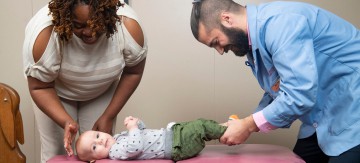[et_pb_section bb_built=”1″ admin_label=”section”][et_pb_row admin_label=”row” background_position=”top_left” background_repeat=”repeat” background_size=”initial”][et_pb_column type=”4_4″][et_pb_text _builder_version=”3.0.105″ background_layout=”light” border_style=”solid” header_2_text_align=”center”]
“Battle Stations” Inspire Healthy Competition in Upper Cervical Technique
[/et_pb_text][/et_pb_column][/et_pb_row][et_pb_row admin_label=”row” background_position=”top_left” background_repeat=”repeat” background_size=”initial”][et_pb_column type=”2_3″][et_pb_image _builder_version=”3.0.105″ src=”https://www.sherman.edu/wp-content/uploads/2018/03/BattleStations7x5.jpg” show_in_lightbox=”off” url_new_window=”off” use_overlay=”off” align=”center” always_center_on_mobile=”on” force_fullwidth=”off” show_bottom_space=”on” box_shadow_style=”preset2″ /][et_pb_text admin_label=”Main Text” _builder_version=”3.0.105″ background_layout=”light”]
Assistant Professor Jaime Browning, D.C., ’09, loves a challenge. So when she adapted a military exercise called “Battle Stations” for her Upper Cervical Technique course three years ago, she was betting her students would be up for it – and they were. It continues to be a favorite class competition, as well as a great way for students to demonstrate their mastery of various knee chest and side posture techniques.
Browning drew inspiration from her own experience in Navy boot camp in Chicago 15 years ago. The final part of her training involved being separated into teams, challenged with many scenarios the Navy faced and put in positions to make difficult decisions, all while the clock was ticking. Time taken to complete the mission successfully was compared to other teams.
“It was terrifying, overwhelming, exhilarating, and pride-inducing,” she remembers. “At the end of the entire exercise, I felt like I accomplished so much. And I loved my fellow sailors for knitting ourselves together to accomplish what felt like the impossible. It was one of the best experiences of my life.”
While chiropractic technique class obviously isn’t the same as combat, Browning says there are some similarities. “Hard work is important,” she says. “Attention to detail is important. Timeliness and fluidity are important. Being held accountable is important.” And these are excellent lessons for her fourth-quarter students.
The students are extremely competitive, some quarters more than others. “I think we all like a challenge,” Browning says. “And a little fun, no-grade-attached competition in a rather tough course lightens the stress load on their shoulders.”
She says this approach engages students actively in the course content and helps them gain confidence. “I often have students say, ‘I think I know more than I thought,’ or ‘This was so much fun.’” Right now, the winning team’s prize is simply bragging rights and a shout-out on Facebook, but Browning has plans to produce a trophy of some sort or medals.
Team Members Enjoy the Competition
Robyn Kirby and Tara Levesque, members of this quarter’s Battle Stations top team, both said the activity requires teamwork, patience, and a competitive spirit. “The best part was the intensity of the competition,” Kirby shared. “The entire class wanted to win! We were all driving each other to do well.”
Levesque agreed. “Our quarter can get pretty competitive,” she said, “so it’s fun to play against each other when we can. Probably the funniest part was watching everyone scramble when it was time to set up. We were all trying to move as quickly as possible without forgetting anything. It’s not easy.”
Kirby said teamwork is a key factor. “The teamwork dynamics were perfect, she explained of her group’s win. “Sometimes one of us couldn’t remember all parts of the setup (line of drive, contact point, torque direction) but we needed and used each other to piece it all together. Browning has taught us that specifically, perfect practice makes perfect.”
And those lessons stick. “It makes it so much easier to really understand the material,” Levesque said. “She was testing all of us to see what we could do without actually feeling the stress of being tested. Dr. Browning has made learning Upper Cervical a lot of fun. She’s challenging us in a fun, positive way, and I like that.”
[/et_pb_text][/et_pb_column][et_pb_column type=”1_3″][et_pb_text admin_label=”Rules” _builder_version=”3.0.105″ background_layout=”light” border_style=”solid”]
Battle Station Rules
- Students are broken into teams of 3, with students rotating the roles of doctor, patient, and observer.
- Once students are into their positions, Browning writes a listing (the misalignment of atlas or axis) on the board, and groups proceed to do the set-up for that listing. The group works as a unit. The patient tells the doctor if he/she is in contact. The observer tells the doctor if they have the correct line-of-drive, correct body angle, correct elbow bend, and if all the minor details of the set-up appear correct. The doctor’s job is to nail this position and hold it until an instructor can get there to review.
- After the positioning is reviewed, the doctor must then show the proper toggle motion in the air for that listing. Nailing a listing gets the team 10 points. One or more errors knocks the score down to five. If the set-up is completely botched, the team gets a zero.
- The first team to finish the listing gets two extra points. Browning emphasizes that students not jump over the 10 points to get the two. “It’s very tempting to be the first to finish,” she explains. “However, if quality suffers, then they have lost more than they have gained.”
- The class goes through 10 rounds, rotating positions within each group. The group with the highest score at the end of 10 rounds is the winner.
[/et_pb_text][/et_pb_column][/et_pb_row][et_pb_row _builder_version=”3.0.49″ background_position_1=”top_left” background_repeat_1=”no-repeat” background_position_2=”top_left” background_repeat_2=”no-repeat” background_position_3=”top_left” background_repeat_3=”no-repeat”][et_pb_column type=”1_3″][et_pb_post_nav _builder_version=”3.0.49″ in_same_term=”off” hide_prev=”off” hide_next=”on” border_style=”solid” border_color=”#0c71c3″ title_font=”|on|||” title_font_size=”16px” show_prev=”on” show_next=”off” /][/et_pb_column][et_pb_column type=”1_3″][/et_pb_column][et_pb_column type=”1_3″][et_pb_post_nav _builder_version=”3.0.49″ in_same_term=”off” hide_prev=”on” hide_next=”off” border_style=”solid” border_color=”#0c71c3″ title_font=”|on|||” title_font_size=”16px” show_prev=”off” show_next=”on” /][/et_pb_column][/et_pb_row][/et_pb_section]






